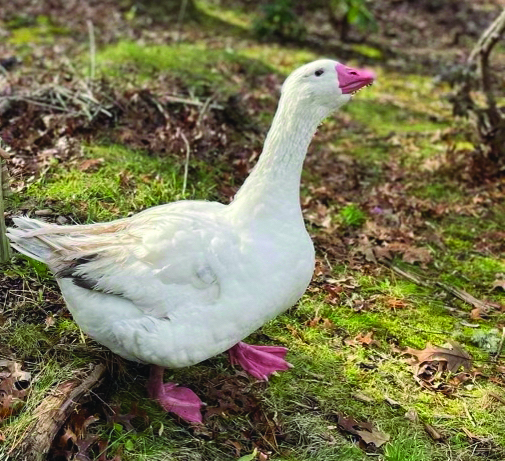If our backyard farm were in my home country of Austria, we’d be trussing up a plump goose for our Christmas feast right about now. But here we are in Wellfleet with a turkey ready to roast and a small gaggle of geese grazing on the winter weeds outside.
European farmers consider turkeys a foolishly expensive luxury. After our experiment with raising them, we learned they are right.
Before you can eat a bird, you’ve got to feed it. And turkeys require a costly, protein-rich diet. They’re relatively fragile fowl. We set out to raise 10 of them last spring and lost five before they were grown.
We didn’t do anything terribly wrong. It’s just that young turkeys, unlike chickens and geese, are prone to illness and malnutrition. Even our marvelous Monsieur Dinde was doomed before a year was up. Domestic turkeys are bred to be on dinner tables before they’re six months old, when they begin to become too heavy for their own legs.

Geese are another story, as we learned when we welcomed four goslings onto our farm this fall. Spruce, our gander, is a white Cotton Patch goose, a breed known for its friendly temperament. Head perpetually high in the air, he proudly marches his gaggle of three Pilgrim goose dames — we call them “the tantes,” meaning aunties — Gertrude, Greta, and Gisela, around our yard.
Both breeds were common, especially in the South, and appreciated for their eggs, meat, and fat — and for the farm work they did. They were relied upon for weeding up until the 1950s or so, when herbicides took over their jobs. Now they are rare birds, critically endangered species, according to the American Livestock Breeds Conservancy. That’s one of the reasons we adopted our four.
The day we brought our small gaggle home, they wouldn’t go into their new goose house at dusk. That first night we had to chase Spruce and his dames around the yard and carry them one by one to their new beds. That experience revealed why goose down is so coveted. Their feathers were so delightfully soft in our arms that we joked about bringing the birds into our own bed instead, to use as pillows.
Geese are remarkably easy to keep. They can happily share a coop with chickens, though they don’t roost perched up high, so they need their own simple house filled with hay to nestle in. Domesticated geese can also be kept outside an enclosure, as they won’t wander far from their home. Our gaggle can eat the same feed as the chickens do, and they love crushed corn, but their favorite food is grass and weeds.
Allowing geese to free range on your lawn will allow you to retire your lawnmower, even as your grass thrives thanks to the gift of natural fertilizer. A small pool or pond for dunking is the one significant adjustment a backyard farmer will need to make for a gaggle. You should never get just one goose, though; like other flock animals, geese are fiercely social.
Geese offer another fringe benefit to the backyard farmer. One of the main reasons we decided to acquire our Spruce is that ganders are excellent protectors — not only of their own gaggles, but of other farm fowl as well.
With increasingly bold coyotes around our property, and hawks overhead, we had been suffering more losses than usual. But Spruce is constantly on the lookout and will honk to warn the rest of the farm of danger, stretching tall and flapping his wings to appear gigantic when a predator is near. He has been so diligent and successful with his patrols that our resident coyote has given up his hillside watch, prompting my husband, Russell, to add the rank of Sergeant Major to Spruce’s name.
While wild geese lay only 5 to 10 eggs per year, domestic geese can lay up to 50. And what they lack in quantity, compared to chickens’ egg-laying capacities, our dames will make up for in egg size: a goose’s egg is three times as large as a chicken’s egg — big enough to fill your palm. Some people say they’re three times as tasty, too. Their higher yolk-to-white ratio means they have a richer, creamier texture, which is why they were traditionally the egg of choice for European delicacies such as crème brûlée and homemade pasta.
It will be a few months before we see for ourselves, though, because goose eggs are seasonal. It is rare for a goose to lay outside the spring season between February and May. And we may opt for something more than mere eggs. Once the dames come into lay, we are hoping that Sergeant Major Spruce will play ball so that we will hear the pitter-patter of tiny webbed feet upon our weeds.



